Columns of Gediminas
The Columns of Gediminas or Pillars of Gediminas (Lithuanian: Gediminaičių stulpai (Gediminids' Pillars); Belarusian: Калюмны (Columns)) are one of the earliest symbols of Lithuania and its historical coats of arms. They were used in the Grand Duchy of Lithuania, initially as a rulers' personal insignia, a state symbol, and later as a part of heraldic signs of leading aristocracy.
| Columns of Gediminas Gediminids' Pillars | |
|---|---|
 | |
| Armiger | Grand Duchy of Lithuania, Republic of Lithuania, Sąjūdis |
| Adopted | It is absolutely certain that since 1397, the Gediminids' Pillars were Vytautas the Great's coat of arms. |
Appearance
The symbol appears in the following form: Horizontal line at bottom, vertical lines extend up at both ends. The Square at the middle of the horizontal line is about half as tall as the vertical lines. Another vertical line rises from the top center of the square, giving an overall appearance that is close to a trident. This form is the one usually seen in modern times, often drawn on walls and fences as protest against the Soviet occupation of Lithuania.
It is notable that the ancient pre-Christian symbols of Lithuania did not follow the same strict rules of heraldry as their western counterparts. Thus this symbol was used in Or and argent, usually on the field gules, and was depicted in various shapes on flags, banners and shields.
Name
The name "Columns of Gediminas" was given in the 19th century by historian Teodor Narbutt, who supposed that the symbol was Gediminas' insignia. The more exact name of the symbol is the Pillars of Gediminids, since there is no direct evidence of its connection with Grand Duke of Lithuania Gediminas.
History
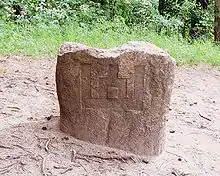
In the Grand Duchy of Lithuania
According to the historical and archaeological evidence, the Columns were used by Grand Duke of Lithuania and Duke of Trakai Kęstutis. They appear on the Lithuanian coins issued by him.[1] The symbol was also used by Vytautas as his personal insignia since 1397 and appeared on his seal and coins.[2] According to the accounts of Jan Długosz, it was derived from a symbol or brand used to mark horses and other property. The Columns were adopted by descendants of Kęstutis as their family symbol, equivalent to a coat of arms. Another user of the Columns of Gediminas was Grand Duke of Lithuania Sigismund Kęstutaitis. At first, the Columns signified the family of Kęstutis, in contrast to the Vytis which was used by Algirdas' descendants. Later on, as a symbol of a ruling dynasty, it was adopted by Jagiellons and the two symbols became state symbols of the Grand Duchy of Lithuania and the Columns of Gediminas remained in use over the following centuries.
In the Interwar Republic of Lithuania
During the period between World War I and World War II they were used by the Lithuanian Republic as a minor state symbol, e. g. on Litas coins and military equipment. The Columns of Gediminas are featured on the Lithuanian Presidential award Order of the Lithuanian Grand Duke Gediminas, that was started in 1928.
In the Soviet Union
After the annexation of Lithuania by the Soviet Union, the symbol was officially banned. During the Singing Revolution of the late 80s, it became the iconic sign of the reform movement Sąjūdis.
In 21st-century Lithuania
The Columns of Gediminas appears in the emblem of the Lithuanian Armed Forces, Land Force, Air Force, Navy, Military Police and National Defence Volunteer Forces.
- Use of the Columns of Gediniminas in modern Lithuania
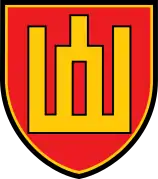 By the Lithuanian Armed Forces.
By the Lithuanian Armed Forces.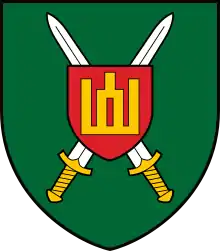 By the Lithuanian Land Force.
By the Lithuanian Land Force.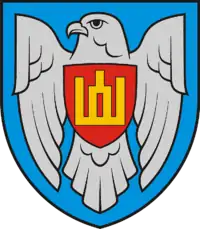 By the Lithuanian Air Force.
By the Lithuanian Air Force.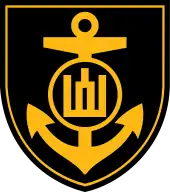 By the Lithuanian Naval Force.
By the Lithuanian Naval Force..jpg.webp) By the Lithuanian Military Police.
By the Lithuanian Military Police..png.webp)
The official logo of the EuroBasket 2011, which took place in Lithuania, is composed of the Columns overlaid on a basketball board.
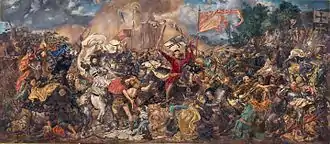
In art
The Columns of Gediminas are displayed to the left of Jogaila in one of Jan Matejko's best-known portraits, although Jogaila's personal insignia was a double cross.
See also
| Wikimedia Commons has media related to Columns of Gediminas. |
- Coat of arms of Lithuania
- Gediminas' Tower
- House of Gediminas
- Polish heraldry
- Symbols of the Rurikids
- Tamga
References
Sources
- Valstybė. Iliustruota Lietuvos enciklopedija
- "Gediminas' Columns". Encyclopedia Lituanica II: 293. (1970–1978). Ed. Simas Sužiedėlis. Boston, Massachusetts: Juozas Kapočius. LCC 74-114275.